Dive Into a Good Book!
"Let us remember: One book, one pen, one child, and one teacher can change the world." -Malala Yousafzai
Oh, My!

Many children are already familiar with the "old lady" books. There are so many now! I am going to focus on one that delivers its own version of the original classic, There Was An Old Lady Who Swallowed a Fly, by Lucille Colandro. The story uses rhyming text and hilarious illustrations to engage the reader. The main character, the old lady, swallows an entire menagerie of animals with each one being bigger than the last. Kids will enjoy the fun, colorful pictures and repetition.
This book would be the perfect book for a lesson on rhyming words or sequencing. Have students cut and paste pictures from the story in sequential order or create a list of rhyming words following a class discussion of the rhyming words found in the story.
Recommended for Ages: 5-8
Lexile Level: AD280L
I Want To Be Friends With the BFG

I LOVE Roald Dahl's, The BFG. Otherwise known as: the Big Friendly Giant. This was the first chapter book I truly enjoyed as I child, and I am currently reading my worn and tattered childhood copy aloud to my son every night. He always begs for me to read one more chapter, reminding me of the same love I had of the story growing up. The BFG centers around a young girl named Sofie, who is scooped up by the giant out of her bed one night. Terrified, because she believes the giant is going to eat her, she soon learns that the BFG is different from normal giants. He is friendly and caring and doesn't eat "human beans" at all. The BFG is full of humor and his silly, jumbled form of language will make any child laugh.
The BFG opens the doors for many lessons and activities including:
- A lesson on character traits, both physical and inner
- A discussion about the BFG's gobblefunk glossary, prompting students to create some made-up words of their own
- Have students create a dream jar like the ones described in the book
- Have students write about their dream(s)
Recommended for Ages: 8-12
Lexile Level: 720L
I'll Eat You Up!

Maurice Sendak's, Where the Wild Things Are is truly a timeless classic. I enjoyed it over and over as a child and my kids enjoy it just the same. The story follows a mischievous little boy named Max who gets sent to his room without any supper. Upon being sent to his room a forest begins to grow...and grow...and grow. Max's imagination takes him on a journey to a faraway place to where the wild things are. And although the wild things gnash their terrible teeth and roar their terrible roars, Max is unafraid and tames them with his magic, becoming king of the wild things. After his adventurous travels Max begins to feel hungry and tired and decides to return home, where his dinner is waiting for him, still warm.
The beautifully detailed illustrations are just as intriguing as the story. Where the Wild Things Are is an enchanting read, and one that many children will be able to make connections with (whether it be imagining faraway lands and monsters, getting sent to your room, or acting like a wild thing). There are some wonderful activities to accompany this book and some of my favorites include:
- STEM Challenge: Design your own wild thing, foil boat, or paper bag tree
- Writing prompt: "I feel wild when..."
- Act out the action words found in the book (roar, march, jump, gnash, etc.)
Lexile Level: AD740L
Recommended for Ages: 4-8
No Pictures?! Really?

Oh, yes. If you did not think it was possible for children to enjoy a book with no pictures than this book will prove differently! If I were to sum up this book in one word it would be: HILARIOUS. The Book With No Pictures, by B.J. Novak, is a fun and entertaining book for children of all ages. The reader is at the whim of the author. The author gets the reader to read the absolute silliest things because, as the reader, "you MUST read whatever the book says....no matter what!" This book will force you to admit that you are a robot monkey, your best friend is a hippo named Boo Boo Butt, and the child you are reading to is the best kid ever. It's a great book to model reading with expression, and to show children how wonderful books can be even if they don't have pictures.
There are so many teaching ideas to go along with this book. Students could:
- Write their own "Book With No Pictures"
- Record an audiobook version of the story
- Create artwork to accompany the pages in the book
- View the hilarious video of the author reading the book: http://thebookwithnopictures.com/
Recommended Age Range: 5-8
Lexile Level: 490L
The Red Book
The Red Book, by Barbara Lehman, allows readers to experience the power of story through illustration alone, as it is a book without words. It's a magical story of a little girl who discovers a red book in a snow pile on her way to school. While at school, her curiosity gets the best of her. The girl opens the book and finds herself looking at a boy who is looking at a book with her in it! (WHAT?!) The children realize at the same time that they are seeing into each other's lives (I can already imagine the most interesting class discussion). The girl decides to set off in search of her new friend by purchasing a big bunch of balloons. As she floats up towards the sky she drops her book, causing both the boy in the story and the reader to ponder if she will make it to her new friend. The little boy can no longer see her in his book and looks very sad, although that moment is brief, because before he knows it, the girl lands right beside him! In the end, we see the red book that the girl dropped being picked up by someone else and we realize the journey is not over.
This book has the ability to transport readers to a faraway place and really activate their imagination. The story can be told from so many different perspectives, and I would be interested to hear of the ways children would interpret it. I would use this book in a writing lesson and have students either write a brief summary reflecting their interpretation of the story or write a prediction about what they think will happen next (younger readers could use drawings to illustrate their predictions).
Guided Reading Level: A
Lexile Level: NP
Recommended for Ages: 4-7
If You Give a Mouse a Cookie
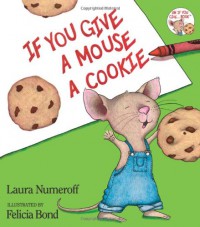
A little boy shares a chocolate chip cookie with an adorable mouse, unaware of the endless requests that will follow. The cookie leads the mouse to ask for a glass of milk, which leads him to ask for a straw, which leads him to ask for a napkin, and so on and so forth. The detailed illustrations in Laura Numeroff's If You Give a Mouse a Cookie bring the story to life and allow children to determine what is happening even if they are unable to read the words. The story is fun to watch unfold and children will certainly find humor in the silly requests being made by the mouse.
This book would be a great way to teach cause and effect. There are several examples found throughout the text, from beginning to end. It would also be the perfect story to practice sequencing. Students could use pictures to illustrate the sequential order of the events in the story.
Lexile Level: AD410L
Have You Seen My Hat?
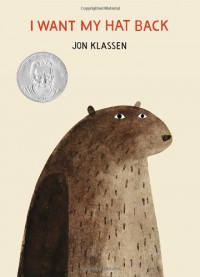
A bear has lost his hat. It's small and red and pointy and he wants it back. In search of his hat, he begins to question each animal he encounters. "Have you seen my hat?", the bear continues to ask. The bear thinks that he will never get his hat back, until he realizes that he has seen it somewhere. Jon Klassen's, I Want My Hat Back, is simple, hilarious, and engaging. This is one of my son's favorite books, a story that we have read over and over again. During my Kindergarten observations, the teacher read this book to her students using different voices to depict each character, and the students LOVED it. The story makes students feel as if they are in on one big joke, and they truly get a kick out of it.
I would use I Want My Hat Back to teach about inferences with my students. What clues from the story can we use to figure out what the text has not told us?
Lexile Level: 230L
Just Keep Swimming

Leo Lionni tells the story of a lone black fish named Swimmy who escaped a horrible fate, leaving him alone in the big sea. At first Swimmy is very lonely and sad, but after venturing through the ocean and seeing many marvelous creatures, he is determined to see the world. He encourages a school of red fish, just like his own, to join him. Through the power of teamwork, Swimmy and the school of red fish all swim close together, creating one giant fish with Swimmy as the eye. Together they are able to chase the big fish away.
This is a beautifully illustrated story about the power of teamwork. I would use this story to discuss the benefits of working together as well as embracing individuality and showing bravery in the midst of fear. It's also important to note that no matter how small you think you may be, you have the ability to make a BIG difference! Students could talk or write about the ways that they can practice teamwork.
Swimmy is also a great book for teaching similes and metaphors. ("as black as a mussel shell", "sea anemones, who looked like pink palm trees swaying in the wind", etc.)
Lexile Level: AD580L
No, David!
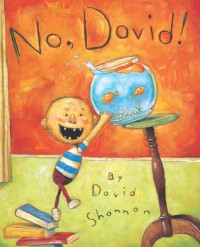
This story is about a mischievous young boy named David, who is always being told "No!" by his mother. David does all sorts of things that he isn't supposed to like wear muddy shoes in the house, play with his food, and run down the street naked (this part will undoubtedly make children giggle). Even though he is constantly being told no, David's mother makes sure to show him affection and tell him that she loves him before the story is over. In No, David, David Shannon keeps the text short and simple and the illustrations bold and eye-catching. The text does not explicitly say what David is doing wrong, but rather, the images depict his poor choices. No, David is a great book for children to learn to read and decode pictures. I also think it would be the perfect book to read at the beginning of the year as establish classroom rules.
Recommended Age: 4-8
Grade Level: P-3
Lexile Level: 100L
Oh, The Thinks You Can Think!

I THINK this book is wonderful, like all Dr. Seuss books. Oh, The Thinks You Can Think is perfect for beginning readers. The sentences are short and easy and the rhymes are witty and fun. The story speaks directly to the reader and leaves us with the message that you can think up anything if you just try! Dr. Suess' silly made-up words and whimsical illustrations always make for an entertaining and engaging read. Oh, The Thinks You Can Think encourages children to not only use their imagination, but to explore the world around them!
I discovered a fun game that would be great to play after reading this book. The game is called "The Imagination Game." Students pull out an object from the "thinker box" and act out what they imagine the prop could be. The box could include things such as a paintbrush, a paper bag, cardboard tubes, or just any little thing you want to throw in. I think the game would be a great way to get students moving, interacting, and using their creative thinking skills!
Recommended for Ages: 5-7
Lexile Level: 360L
Imagine That
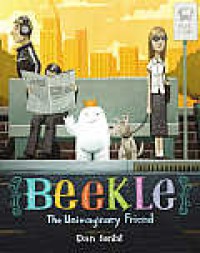
The Adventures of Beekle, The Unimaginary Friend tells the story of Beekle, an adorable little marshmallow-looking character who is in search of a real child. You see, Beekle comes from a faraway land, where day after day he patiently awaits for a child to imagine him. After waiting for many nights he decides to do the unimaginable: embark on a journey to the real world. This short story is full of bright, beautiful illustrations and will undoubtedly capture the hearts and imaginations of young readers. Many children will be able to connect with the story by relating an imaginary friend that they once had (or have) with Beekle.
After reading the story aloud I would discuss the themes of friendship and bravery. ("Beekle faced many scary things on his quest to find his friend...what are some ways that you show courage?") Another way to follow up the story would be to have students design their own imaginary friend. Since Beekle resembled a cute marshmallow puff, give students marshmallows (both jumbo and small), toothpicks, a sharpie, foil paper, scissors, and tape and let them go to town crafting their new friend! I also love the idea of connecting the story to Maurice Sendak's Where The Wild Things Are. In what ways are the stories alike? In what ways are they different? Students could draw a Venn Diagram to show the relationship between the two.
Recommended for Ages: 5-7
Lexile Level: AD480L
Once There Was a Tree

The Giving Tree is one of my favorite children's books of all time. Yes, it is a bit sad, but I think it's important to recognize the way a book can make us feel, even if it is a feeling of sadness. The important thing to focus on with this book is the trees act of selflessness. The story follows a boy from childhood to adulthood as he visits the tree throughout different stages of his life. At each stage the boy wants something and the tree continues to give pieces of herself to the boy because it makes her happy. In the end, when the boy is an old man, he no longer wants anything tangible, but simply a quiet place to rest. That is when the tree offers him her stump. And the tree is happy.
As the story unfolds we learn that the boy takes and takes from the tree without giving back anything in return. I think this is poses the question, "How would you feel if you were the tree?" There are many theories and interpretations of the book, but at its core, I believe the book is a reflection of unconditional love and generosity.
I like the idea of using this book to focus on character education, mainly the act of being kind. After reading this book to my students, I would facilitate a whole group discussion about the ways that the tree exhibited kindness. I would then ask my students, "What are some ways that you can show kindness?" As a matter of fact, this would be a great writing prompt.
Additional lessons using The Giving Tree include:
- Cause and Effect
- Problem/Solution
- Character Traits of the boy and the tree
Lexile Level: 720L
Mo' Mo Willems!

On the day that I was introduced to author-illustrator Mo Willems by my dear professor two years ago, I immediately became a fan. I can remember taking my then four-year old son to the library and sharing my newfound love of his literature. It didn't take long for my son to become a fan as well, nor did it take long for us to read our way through every available book of his that our library had to offer. Mo Willems has published an extensive collection of children's books, and Don't Let the Pigeon Drive the Bus is one of my many favorites. Through simple, cartoon-style illustrations and minimal words, Willems quickly captures his audience from the start, where the bus driver asks the reader to not allow the pigeon to drive the bus while he steps out of the picture. The pigeon begs and pleads with the reader, which is as equally engaging as it is hilarious. Children adore Mo Willems books and are without a doubt intrigued by his simple, cartoon-like illustrations and direct discourse.
Mo Willems stories are fun and interactive, often exploring themes of friendship and emotion. Don't Let the Pigeon Drive the Bus is a great book to include in a lesson on opinion writing. (Should the pigeon drive the bus? Why or why not?)
I would love to conduct an author study on Mo Willems, allowing students to learn about and explore his craft (thought bubbles, speech bubbles, expression words, facial expressions, direction lines). There are an abundance of Mo Willems activities on Pinterest just calling my name!
Lexile Level: 280L
SOME BOOK!

It is one of the most beloved children's books of all time and even received the Newberry Honor Award. Charlotte's Web tells the remarkable story of an unlikely friendship between a pig named Wilbur and a spider named Charlotte. When Wilbur is in danger of being slaughtered by a farmer, Charlotte writes messages praising Wilbur (such as "Some Pig") in her web in order to persuade the farmer to let him live. Charlotte's Web explores the innocence of childhood, friendship, the cycle of nature, imagination, and modern fantasy in a tender and heartwarming way.
Charlotte's Web is a book that can introduce lessons and activities across the curriculum.
Thanks to the internet, the possibilities of using this book in the classroom are truly endless. Some of my favorite ideas include:
- Explore the life cycle of spiders. Students can create a model using yarn, cotton, balls, plastic spiders, and construction paper to depict the various stages.
- Discuss the beautiful and intriguing words you come across as you read the story together and display them in a gauzy spiderweb word wall.
- Design a campaign poster to save Wilbur.
- STEM challenge: Students team up to make a model of Wilbur’s pigpen or one of their own original design. Provide an assortment of materials such as popsicle sticks (small and large), cardboard, foil, tape, scissors, and straws and let your kids loose!
Lexile Level: 680L
Recommended Age Range: 7-9
Today's Forecast: A Storm of Pancakes!

Cloudy with a Chance of Meatballs takes the reader on a journey to the unpredictable town of Chewandswallow, where breakfast, lunch, and dinner fall from the sky! The story begins when Grandpa sits down with his grandchildren to tell the best tall tale ever. He tells of all of the delicious food that the townspeople eat and how they go outside with their plates and utensils for each meal. As the story unfolds, we learn that the town begins to encounter some bad weather when portions increase and things like overcooked broccoli and a pea soup fog begin to blow in. The townspeople are frustrated and the sanitation department can no longer keep up. Things get out of of control and the citizens of Chewandswallow realize that they must abandon their once delightful town.
Children have enjoyed Judi Barrett's classic book Cloudy with a Chance of Meatballs for over 30 years, and honestly, it never gets old. The book is silly and fun and allows children to activate their imagination.
There are many possible lessons and activities that could incorporate a read-aloud of the story which include:
- Compare/Contrast Venn Diagram (Students compare the town of Chewandswallow to the town that they live in)
- Science lesson on weather
- Compound words
- Sentence prompts
Lexile Level: AD730L
Caterpillars in Kindergarten
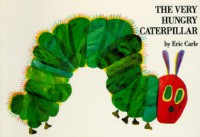
The Very Hungry Caterpillar is a book that children will enjoy over and over again. Eric Carle brings the short story to life with 3-D pages and vibrant illustrations. Children are immediately captivated as they read about a tiny and very hungry caterpillar that consumes a number of different foods, from strawberries to salami. From Sunday to Saturday this caterpillar makes his way through so much food that, once Sunday rolls around again, he is no longer a tiny caterpillar, and he is no longer hungry. After forming a cocoon around himself we wonder what will happen next of the not-so-tiny caterpillar. Eric Carle's one-of-a-kind illustrations feast the readers' eyes on the most exciting part of the story: a beautiful butterfly!
The Very Hungry Caterpillar would be a fun and engaging story to read aloud to a Kindergarten class. This is the perfect book for a lesson on days of the week, numbers and counting, sequencing, and even the metamorphosis of caterpillar to butterfly.
Additional activities include:
- Writing prompts ("If I were a very hungry caterpillar I would eat...")
- Beginning/Middle/End lesson
- Graphing lesson (Graph the amount of food the caterpillar ate each day)
Lexile Level: AD460L



